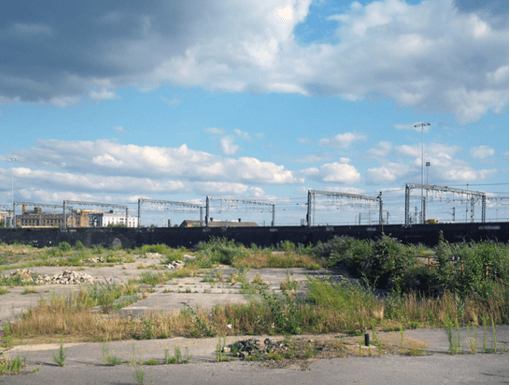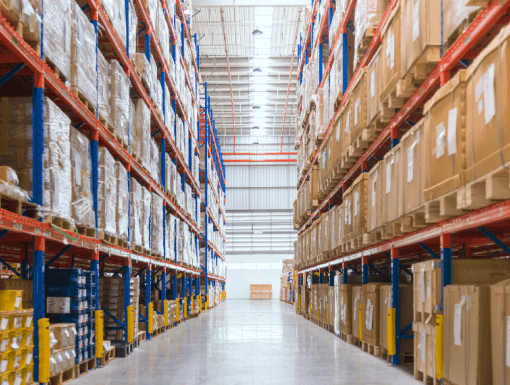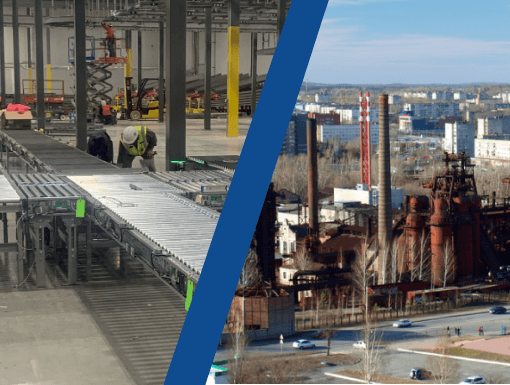A note before we start: The term brownfield is used interchangeably in the construction and supply chain industry and has different meanings. This article will look at brownfield sites in the construction industry. Click the following link if you’d like to learn more about brownfield projects for the supply chain.
What is a Brownfield Site in Construction?
A brownfield site is any previously-developed land being redeveloped for a new business. A contaminated controlled substance may complicate the redevelopment due to industrial activity, military, or petroleum exploration. It can be as small as a corner lot, cover hundreds of acres, and is almost always situated on a significant commercial or military thoroughfare or railroad line.
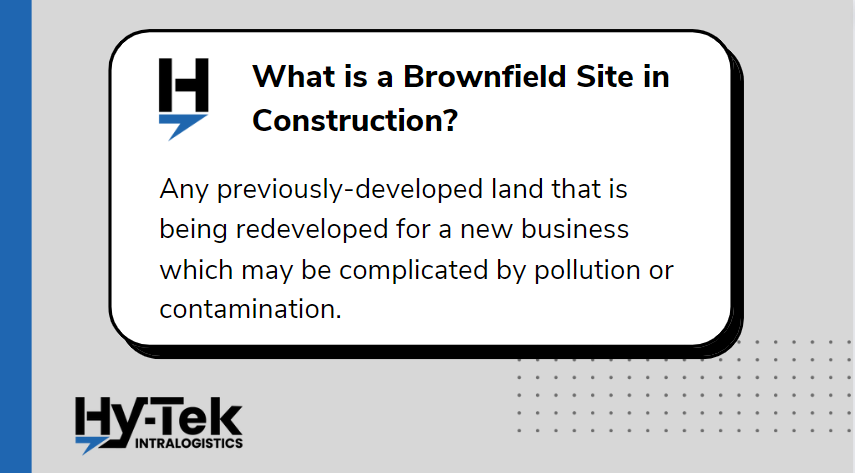
There are an estimated 450,000 brownfields nationwide, according to the USEPA. And thanks to the Brownfields Revitalization Act of 2001, the government can authorize up to $200 million per year for brownfield site assessments and cleanup as part of the Summary of the Comprehensive Environmental Response, Compensation, and Liability Act (AKA Superfund).
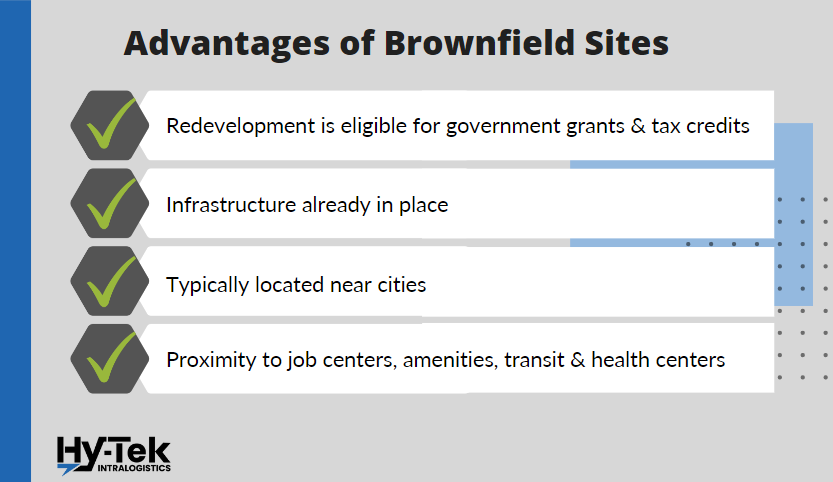
What are the Advantages of Brownfield Sites?
If you’ve decided that you’re going to develop a brownfield site, then here are a few of the advantages that will help you make the right choice during site selection:
- The redevelopment of brownfield land is often eligible for government grants and tax credits, which can offset redevelopment costs.
- Since they have already been developed, brownfield sites often have the necessary infrastructure, including roads, utilities, and drainage.
- They are often located in metro areas with good connections to local infrastructure, making them convenient for businesses that need a large labor pool, amenities, transit, and health centers.
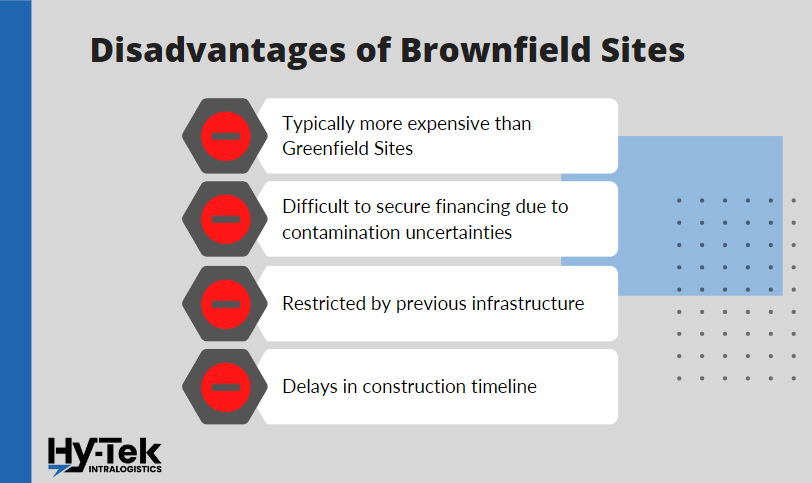
What are the Disadvantages of Brownfield Sites?
When considering a construction project, developers must take a variety of factors into account, including the cost of the land and the timeline for completion. Below are some of the most common disadvantages.
- Brownfield sites can be more expensive than greenfield development projects due to environmental cleanup.
- Difficulty securing financing, as lenders are often reluctant to invest in projects with uncertainties around environmental contamination.
- The existing network might restrict the infrastructure and need to be reworked.
- Delays in the construction process are common as developers secure the necessary permits.
Types of Contaminated Lands
When choosing your warehouse location, several factors are at play, but a basic environmental assessment for the brownfield redevelopment process would cover three areas.
Class I sites pose the most significant risk to human health and the environment and require stringent cleanup measures. These sites are typically large, complex, and can damage public health or the environment.
Class II sites pose a significant risk to human health and the environment and require action.
Class III sites pose minimal risk to human health and the environment and require the least stringent cleanup measures. These sites are typically small, have only a few contaminants, and are not easily accessible to people or animals. However, the EPA goes into far greater detail when defining the different types of contaminated property.
The Superfund National Priorities List
This includes some of the most toxic spots in the United States:
- Industrial sites, waste management sites, mining and sediment sites, and federal facilities like abandoned mines.
- Nuclear, biological, chemical, and conventional weapons production plants.
- Military base industrial areas.
Resource Conservation and Recovery Act (RCRA) Cleanup Facilities
RCRA regulations require that these sites be cleaned up because of their past or present treatment, storage, or hazardous waste disposal. They have previously had spills of contamination and must now be cleaned up.
Underground Storage Tanks/Leaking Underground Storage Tanks
Petroleum and hazardous materials are stored in huge underground storage tanks that may collapse owing to faulty components, installation, operating procedures, or maintenance mechanisms, resulting in contaminated soil and groundwater pollution.
Accidental Spill Sites
Hundreds of thousands of oil, gas, and chemical spills occur on land and in water each year due to various causes, such as transportation (e.g., rail, barges, tankers, pipelines), facility releases, and other types of events.
Sites Contaminated by Natural Disasters or Terrorist Activities
Earthquakes, floods, fires, and hurricanes are natural disasters that may contaminate lands and create difficulties at already-contaminated locations.
Land Contaminated with Radioactive and Other Hazardous Materials
As a result of activities connected with nuclear weapons production, testing, and research, numerous locations in the United States have been contaminated with radioactive and other hazardous materials.
Brownfields
Brownfields are an opportunity for states to increase revenues by auctioning state-owned or tax-delinquent property. Brownfield cleanup and investment, as well as the use of vacant land for economic development, protect the environment, reduce blight, and relieve development pressures in green spaces and working lands.
Military Bases and Defense Sites
The Department of Defense uses millions of acres across the United States for training operations and military exercises. The use of hazardous substances and pollutants, discarded munitions, munitions components, unexploded ordnance, and construction demolition debris have contaminated some of these lands. Similarly, the Department of Energy owns numerous facilities where toxic chemicals or radioactive substances have been polluted due to past nuclear weapons production.
PCB-Contaminated Sites
Before the Toxic Substances Control Act, polychlorinated biphenyls (PCBs) were widely utilized in various commercial sectors, and extensive PCB pollution resulted from spills and releases and product usage and disposal.
Abandoned and Inactive Mine Lands
A mine may be abandoned and left inactive. Yet, it may still contain features ranging from exploration holes to entire-scale, large-scale mine openings, pits, waste dumps, and processing facilities.
Knowing a brownfield site is crucial if you are looking at a redevelopment project is crucial. contact the EPA for guidance and next steps if you are concerned that your site may be chemically contaminated.
Steps to Take When There is No Contamination
When constructing a new warehouse, it is vital to consider several factors to ensure a successful build.
- Remove any unwanted pre-existing structures.
- Design your warehouse.
- Level the land to prepare for construction.
- Build the foundational areas around the warehouse, such as the parking lot, utility lines, etc.
- Begin construction.
- Check that the warehouse meets all safety and code requirements.
Steps to Take When There is Contamination
- A remedial site assessment and feasibility study to evaluate the site’s extent of contamination and the potential threat to humans and the environment.
- A Record of Decision (ROD) is formed. The ROD addresses an EPA-recommended remedy and cleanup plan.
- A detailed cleanup plan is implemented during a phase referred to as the remedial design/remedial action (RD/RA) stage. The RD/RA stage includes drawings and specifications for the construction and cleanup of the site.
- Level the land to prepare for construction.
- Build the foundational areas around the warehouse, such as the parking lot, utility lines, etc.
- Begin construction.
- The construction is completed, marking the entire cleanup of the site, and a final survey of all contaminants is finalized.
- Developing a plan for routine site monitoring, reviews of cleanup efforts, and enforcing long-term site restrictions.
- Working with the EPA to ensure safe usage of the site to allow for a low long-term environmental impact.
Who Determines the Contamination Levels of a Brownfield Site?
The US Environmental Protection Agency (EPA) and the State Voluntary Cleanup Program (VCP) local government work together to determine the contamination levels of a brownfield project.
They define brownfields sites as “real property, the expansion, redevelopment, or reuse of which may be complicated by the presence or potential presence of a hazardous substance, pollutant, or contaminant.”
To determine the level of contamination at a given site, the EPA and the VCP consider many factors, including the types and concentrations of contaminants present, the amount of time that has passed since contamination occurred, and the potential for human exposure. Based on this information, the EPA and VCP can develop a cleanup plan to address each site’s specific needs.
FAQ
What is the meaning of a brownfield site?
A brownfield site is a previously developed property that may be difficult to develop, expand, or refurbish due to current infrastructure and potentially hazardous substances, pollutants, or contaminants.
What is the difference between a greenfield and a brownfield site?
A greenfield is a piece of agricultural or forest land and any other site designated for commercial buildings development, industry projects, or other construction activities that have not been previously developed. Brownfield land is a property where hazardous materials, pollutants, or contaminants exist and might make development or rehabilitation difficult.

